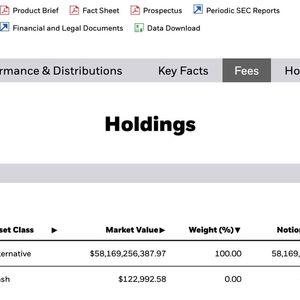Big news dropped recently concerning the potential future of money in the United States. The conversation around a US CBDC , or Central Bank Digital Currency, has been ongoing, but a recent statement from a high-ranking official has certainly stirred the pot. According to reports, the US Treasury Secretary has expressed a clear lack of support for the idea of the Federal Reserve issuing its own digital currency. What Did the US Treasury Secretary Say About the Digital Dollar? The core of the recent report, initially shared by Watcher Guru on X, is the stance attributed to the US Treasury Secretary . The Secretary reportedly stated a lack of support for the Federal Reserve moving forward with a central bank digital currency . Even more pointedly, the concept was described as a “sign of weakness.” This isn’t just a casual comment; it’s a significant signal from a key figure in the nation’s financial leadership. This statement adds a notable voice to the ongoing debate surrounding the creation of a digital dollar . While the Federal Reserve has been researching and discussing the possibility, indicating no immediate plans but exploring the technology and implications, this Treasury perspective introduces a strong note of caution, if not outright opposition, from the executive branch’s financial arm. Why is a Federal Reserve Digital Currency Being Discussed? The idea of a Federal Reserve digital currency stems from several factors driving central banks worldwide to consider their own digital money. These include: The rise of private digital currencies: Cryptocurrencies like Bitcoin and stablecoins have highlighted public interest in digital forms of money, prompting central banks to consider offering a state-backed alternative. Improving payment systems: Proponents argue a CBDC could potentially offer faster, cheaper, and more efficient payment systems compared to existing infrastructure. Financial inclusion: A digital dollar could theoretically provide easier access to financial services for unbanked or underbanked populations. Maintaining monetary sovereignty: In an increasingly digital and globalized financial landscape, some argue a CBDC is necessary for a central bank to effectively implement monetary policy and maintain control over its currency’s ecosystem. International competitiveness: As other nations explore or launch their own CBDCs, there’s a concern the US could fall behind in financial innovation without its own US CBDC . Despite these potential motivations, the path to creating a digital dollar in the U.S. is complex and faces numerous hurdles. Is a US CBDC a Sign of Weakness, and Why? The Treasury Secretary’s characterization of a Federal Reserve digital currency as a “sign of weakness” is particularly noteworthy and warrants deeper examination. While the specific reasoning behind this phrasing wasn’t detailed in the initial report, we can infer potential arguments that align with such a view: Undermining the Existing System: Critics argue that introducing a CBDC could disrupt the existing two-tiered banking system, potentially drawing deposits away from commercial banks and concentrating financial power with the central bank. This could be seen as a sign of weakness in the private banking sector or an overreach by the government. Privacy Concerns: A government-issued digital currency raises significant privacy concerns. Opponents fear it could enable unprecedented government surveillance of citizens’ financial transactions, which some might view as a characteristic of less free or weaker societies where individual privacy is compromised. Competition with Private Innovation: The U.S. has a strong history of private sector innovation in payments and finance. Some argue that a government-backed digital dollar could stifle this innovation or unfairly compete with private stablecoins and payment solutions, implying a lack of confidence in the market’s ability to evolve on its own. Security Risks: Centralizing a nation’s currency infrastructure into a single digital system could create a massive, attractive target for cyberattacks, potentially exposing the country to significant financial instability – arguably a sign of systemic vulnerability or weakness. Necessity and Justification: Some argue that the U.S. already has efficient digital payment systems (like credit cards, apps, etc.) and that the stated benefits of a CBDC do not outweigh the significant costs and risks. Pursuing a CBDC without a clear, compelling need could be seen as an unnecessary and potentially destabilizing endeavor, perhaps indicative of a weak rationale. These points highlight that the “sign of weakness” comment likely reflects concerns about potential negative impacts on the existing financial structure, individual liberties, market dynamics, or national security, rather than weakness in the technology itself. Comparing the Digital Dollar Debate: Pros vs. Cons The debate around a central bank digital currency in the U.S. is multifaceted, involving a wide range of potential benefits and significant challenges. Here’s a simplified comparison: Potential Benefits (Arguments For) Potential Challenges (Arguments Against) Faster & Cheaper Payments Privacy Concerns & Surveillance Risk Increased Financial Inclusion Cybersecurity & Systemic Risk Enhanced Monetary Policy Tools Disruption to Commercial Banking International Competitiveness Implementation Costs & Complexity Potential for Innovation Stifling Private Sector Innovation The statement from the US Treasury Secretary clearly aligns more with the “Challenges” column, emphasizing potential downsides over perceived benefits. What Does This Mean for the Future of a US CBDC? The opinion of the US Treasury Secretary carries significant weight within the executive branch and influences policy discussions. While the Federal Reserve operates independently, its decisions on something as monumental as issuing a Federal Reserve digital currency would undoubtedly involve extensive consultation and consideration of views from across the government, including the Treasury. This public stance suggests a high-level resistance within the current administration towards the concept of a digital dollar . It doesn’t necessarily kill the idea entirely, as research and debate will likely continue, but it certainly places a significant political hurdle in its path. It signals that any proposal for a US CBDC would face strong opposition from at least one key financial leader. For cryptocurrency enthusiasts and those following the evolution of digital finance, this development is crucial. It underscores the complex political and economic considerations at play beyond just the technological feasibility of a central bank digital currency . It also highlights that the U.S. approach to digital money may continue to favor private sector innovation (like stablecoins) over a direct government-issued alternative, at least for now. Actionable Insights: What Should You Watch For? Given this development, here are a few things to keep an eye on: Further Statements: Will other government officials or Federal Reserve governors echo or counter this sentiment? Legislative Action: Will Congress take steps to either prohibit or authorize the exploration/creation of a digital dollar ? Several bills related to this topic have already been introduced. Federal Reserve Research: How will the Fed’s ongoing research and publications reflect or respond to this high-level feedback? Global Developments: Will progress or issues with CBDCs in other countries influence the U.S. debate? Private Sector Innovation: Will the focus shift further towards regulating and integrating private stablecoins as the primary form of digital dollar in the U.S.? The landscape for a US CBDC remains uncertain, but this recent statement provides a strong indication of the challenges it faces at the highest levels of government. Compelling Summary: The Digital Dollar Debate Takes a Negative Turn In summary, the reported statement from the US Treasury Secretary , rejecting the notion of a Federal Reserve digital currency and labeling it a “sign of weakness,” marks a significant moment in the ongoing debate. It introduces a powerful voice of opposition from within the executive branch, adding complexity to the Federal Reserve’s exploration of a central bank digital currency . While the potential benefits of a digital dollar are discussed, concerns surrounding privacy, financial stability, and market impact appear to be weighing heavily on some key decision-makers. This development suggests that the path towards a US CBDC is likely to be challenging and highlights the deep divisions that exist regarding the role of government in the future of digital money. To learn more about the latest US CBDC trends and the broader debate around the digital dollar , explore our articles on key developments shaping the future of money and finance.



















